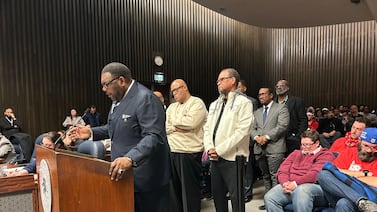Colorado’s superintendents still see plenty of room for improvement after an independent audit found the state’s school accountability system is working as designed.
Bret Miles, executive director of the Colorado Association of School Executives, said his organization’s top legislative priority will be the creation of a task force to recommend changes to the system, which rates schools and districts based largely on test scores and allows for state intervention in those that perform poorly for many years in a row.
“There are areas where we can evolve and do better,” Miles said. “We need an accountability system that incentivizes innovation.”
Colorado school districts and community groups had urged lawmakers to request the audit to look for evidence the accountability system is biased and hurting the low-income students of color it was supposed to help. Districts and schools with low ratings often serve more students in poverty than those with higher ratings, and some educators contend low standardized test scores reflect conditions outside their control.
Opponents of the accountability system hoped to use the audit as a springboard for larger reforms of a system that’s been in place since 2009.
But before legislation was finalized, supporters of the accountability system drafted amendments that placed limits on the scope of the audit — and secured the support of Gov. Jared Polis, who is a supporter of education reform and test-based accountability.
When the audit was released Monday, it described the system as “reasonable and appropriate” and working largely as legislators intended. Supporters of test-based accountability said the findings were encouraging.
“I don’t see the bones of the accountability system changing much,” said Brenda Dickhoner, CEO of the conservative education advocacy group Ready Colorado.
In particular, they were pleased to see that schools that took advantage of state education department help showed improvements in test scores.
“It’s a confirmation of the importance of what we do with this data, that schools and districts that need the most help get that help and it’s working,” said State Board member Rebecca McClellan, a Littleton Democrat, during a Wednesday presentation on the audit.
But board member Lisa Escárcega, a Denver Democrat and previous director of CASE, the school executives group, asked pressing questions about whether the audit determined which types of help were most effective, how data from large and small schools varied, and whether state tests measure the quality of instruction or outside factors like poverty.
Researchers from the Human Resources Research Organization, known as Humrro, said the audit was not designed to answer those questions.
For Miles, that’s a key point. He said he was neither surprised nor disappointed in the results, given the scope of the audit outlined in 2021 legislation. Instead, he said he’s pleased the audit identified certain gaps in the system.
“There were several places where they clearly laid out areas for improvement, areas that CASE members have been talking about for years,” he said.
For example, the audit noted that measurements are less accurate in small schools and districts, where a handful of students doing better or worse in a given year can make a big difference in average scores. And some schools with high ratings don’t meet benchmarks on every measure, while some schools with the lowest “turnaround” rating still have bright spots.
In addition to standardized test scores, Colorado uses a growth measure that shows student progress, graduation rates, college enrollment, and workforce readiness.
The audit also noted a correlation between having more students in poverty and lower average test scores. Even many highly rated schools and districts still report lower average scores for students in poverty and students of color.
The audit went on to say that students with more access to advanced coursework and career and technical education had better outcomes, while schools and districts with more students in poverty had fewer such courses.
“The question that is not addressed in the audit is: What role does the accountability system play in that?” Miles said. “If I have a district that is not meeting performance targets, what pressure is the district under to raise test scores rather than offering those classes? What role has the accountability system played in stifling innovation?”
Miles said the current system is punitive even if districts that got help improved. A label like “turnaround” turns off parents and teachers, who go to other districts and make it harder to improve.
Supporters of test-based accountability also see some areas for potential change, such as improving how schools communicate with parents about test scores and ratings and holding high-performing districts accountable for gaps in how they serve students in poverty.
Miles said these questions and others could be answered by a task force made up of educators and administrators.
He said educators don’t want to scrap the whole system, and the audit itself supports the need for change.
“Why would we do this at all if we’re not going to use it to make things better?” he said.
Bureau Chief Erica Meltzer covers education policy and politics and oversees Chalkbeat Colorado’s education coverage. Contact Erica at emeltzer@chalkbeat.org.





